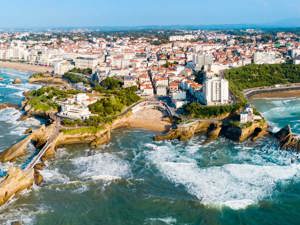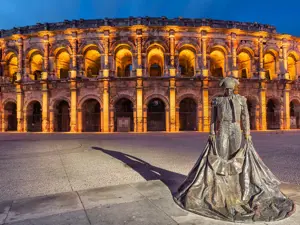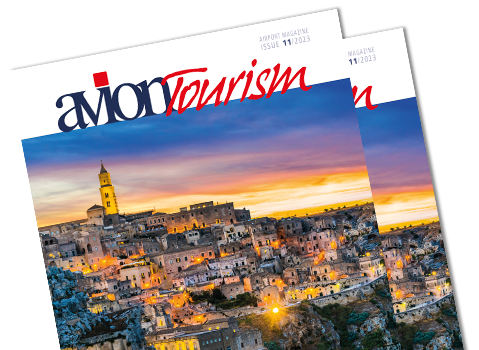The capital of Art Nouveau
Nancy, the capital of the dukes of Lorraine, is an extraordinary example of how artistic and architectural influences blend perfectly with modern features to create the cultural heritage and lifestyle typical of a city.

The city of Nancy Copyright © Sisterscom.com, Shutterstock
The heart of Nancy is the majestic Place Stanislas, dedicated to the Polish king Stanislaw Leszczynski, father-in-law of Louis XV, who ruled over Nancy from 1738 to 1766, building great urban works and promoting the spread of knowledge of science and the arts. The square, restored and renovated in 2005, is the meeting place of the inhabitants of the city. Surrounded by five palaces, one of which houses the Museum of Fine Arts, and two buildings of only one floor, it became a UNESCO world heritage site in 1983.

The Place Stanislas in Nancy Copyright © Sisterscom.com, Shutterstock
Among the many monuments two can also be found in Paris; one is the “Arc de Triomphe”, built 250 years ago in honour of King Louis XV, the main facade of which overlooks Place Stanislas and resembles the Arch of Septimius Severus in Rome. The other is the majestic Cathedral of NotreDame, dating back to the first half of the XVIII century.

The Arc de Triomphe in Nancy Copyright © Sisterscom.com, Shutterstock
Even the Opera Theatre was inspired by the Opèra Garnier in Paris. The tomb of Stanislas is instead found in the church of Notre-Dame-de-Bon-Secours, a place of pilgrimage.

Notre-Dame-de-Bon-Secours in Nancy Copyright © Sisterscom.com, Shutterstock
The cross of Lorraine, symbol of the city and the Ducal House, is featured on the Porte de la Craffe, the only remaining gateway of the 14th century fortifications.

The Porte de la Craffe in Nancy Copyright © Sisterscom.com, Shutterstock
A place to enjoy and take a stroll is the Pepinière, a park of 23 hectares that was initially a plant nursery, but today has even a zoo. An extraordinary collection of plants and flowers can be found in the city’s botanic garden, including a magnificent example of the Ginko biloba tree.

Art nouveau style pavilion in botanic garden in Nancy Copyright © Sisterscom.com, Shutterstock
The historic centre is rich in churches, monuments and Rennaissance buildings. In the Ducal Palace, today home of the Lorraine Museum, Gothic style lives harmoniously alongside that of the Renaissance. Nancy has many Art Nouveau buildings, designed by architects at the start of the twentieth century. The commercial quarter and the station are the most representative building of the Art Nouveau style.
The Maison Biet dates back to the beginning of the twentieth century, the first stepped construction in France situated in rue Pasteur, a short distance from the Ecole de Nancy Museum (School of Nancy), which houses a rich collection of works that characterise this extraordinary movement of renewal of the decorative arts developed in the city between 1885 and 1914. The School of Nancy is also famous for practising hypnosis, introduced by the pharmacist Emile Coué as a method of autosuggestion to help cure illness.
Not to be missed is a visit to the Maison des Soeurs Macarons in rue Gambetta to try their famous macaroons, soft round almond biscuits created in the eighteenth century. Other specialities include the Berg’amour, jellied sweets flavoured with bergamot, and the Perle de lorraine, with a heart of brandy and Mirabelle plums. Master confectioners are Alain Bitt and Au Duchè de Lorraine, in rue Hanri-Poincarè which sells fine art china alongside its delicacies.
Text by Luca Lembi
Updated by Alisè Viyti
Avion Tourism Magazine
Photos: Sisterscom.com, Shutterstock
Photos: Sisterscom.com, Shutterstock
All rights reserved. Copyright © Sisterscom.com
Tourism Board
www.nancy-tourisme.fr
www.atout-france.fr
Partnership with Booking.com
Where to sleep in Nancy

Nancy Copyright © Sisterscom.com, Shutterstock
Nancy is a welcoming city and offers various possibilities for accommodation.
To find the ideal hotel and the best offers you can do a search for the stars but also for districts or landmarks.
STARS
Hotels for stars, differentiated by type of services:
LANDMARKS
Hotels in tourist areas
LANDMARKS
Hotels in tourist areas
AIRPORT
Hotels near the airport
Tours and excursions in Nancy
Partnership with GetYourGuide
You might be interested in
Destinations found in the vicinity
Other destinations































